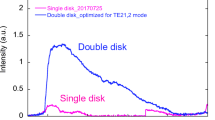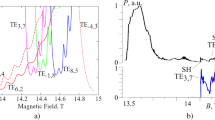Conclusion
Mode competition — interaction between a mode and another mode — is due to the non-linearity of the relativisitc factor γ. At the beginning of a multimode oscillating, the behavior of the multimode oscillating is only dependent on the ratio of mode frequency and relativistic cyclotron frequency and is in agreement with that described by single mode theory. In non-linear domain mode interaction depends on both amplitudes of A1 and A2 and phase difference Δi of the two modes. The main effect of mode interaction is that excitation of the parasitic mode suppresses growth of the operating mode.
Under the operating conditions with high efficiencies, a mode interaction between the dominant mode and the lower lateral mode is almost unavoidable, especially in the gyrotron operating with a cavity at higher order modes to increase the capability of output power.
Similar content being viewed by others
References
V. A. Flyagin et al., IEEE Trans. MTT, Vol. MTT-25, 514–521 (1977).
M. I. Petelin et al., Radiophysics and Quantum Electronics, Vol.17, 686–690 (1974).
K. R. Chu, Phys. Fluids, Vol.21, 12, 2354–2364 (1978).
K. E. Kreischer et al., Int. J. Infrared and Millimeter Waves, Vol.1, 2, 195–223 (1980).
G. N. Rapaport et al., Radiophysics and Quantum Electronics, Vol.12, 4, 587–595 (1967).
M. E. Read et al., IEEE Trans. MTT, Vol. MTT28, 4, 318–325 (1980).
H. Döring and Yu Wei Int. J. Infrared and Millimeter Waves, Vol.2, 437 (1981).
C. L. Chang et al., Int. J. Electronics, Vol.51, 4, 595–606 (1981).
A. A. Kurayev, Optimization method in the UHF-Electronics problem, Minsk (1975).
M Zhu and H. S. Wu, J. Applied Science (in chinese), Vol.1, 2, 165–174 (1983).
M. A. Moiseyev and G. S. Nusinovich, Radiophysics and Quantum Electronics, Vol.17, 11, 1305–1311 (1974).
G. S. Nusinovich, Int. J. Electronics, Vol.51, 4, 457–474 (1981).
S. N. Vlasov et al., Radiophysics and Quantum Electronics, Vol.12, 8, 972–978 (1969).
V. Y. Zapevalov et al., Radio Engineering and Electronic Physics, Vol.22, 86–94 (1977).
Y. Carmel et al., Int. J. Infrared and Millimeter Waves, Vol.3, 5, 645–665 (1982).
A. V. Gapanov et al., Int. J. Electronics, Vol.51, 4, 277–302 (1981).
G. F. Brand et al., IEEE Trans. MTT, Vol. MTT32, 1, 58–64 (1984).
K. Kreischer et al., IEEE Trans. MTT, Vol. MTT32, 5, 481–490 (1984).
J. C. Slater, Microwave Electronics, D. Van Nostrand Company, Inc., New York (1950).
Author information
Authors and Affiliations
Additional information
A research fellow of the Alexander von Humboldt Foundation coming from Beijing Vacuum Electron Devices Research Institute, Beijing, China
Rights and permissions
About this article
Cite this article
Zhu, M., Döring, H. Mode competition of the gyrotron under high efficiency operating conditions. Int J Infrared Milli Waves 7, 653–672 (1986). https://doi.org/10.1007/BF01013283
Received:
Issue Date:
DOI: https://doi.org/10.1007/BF01013283




